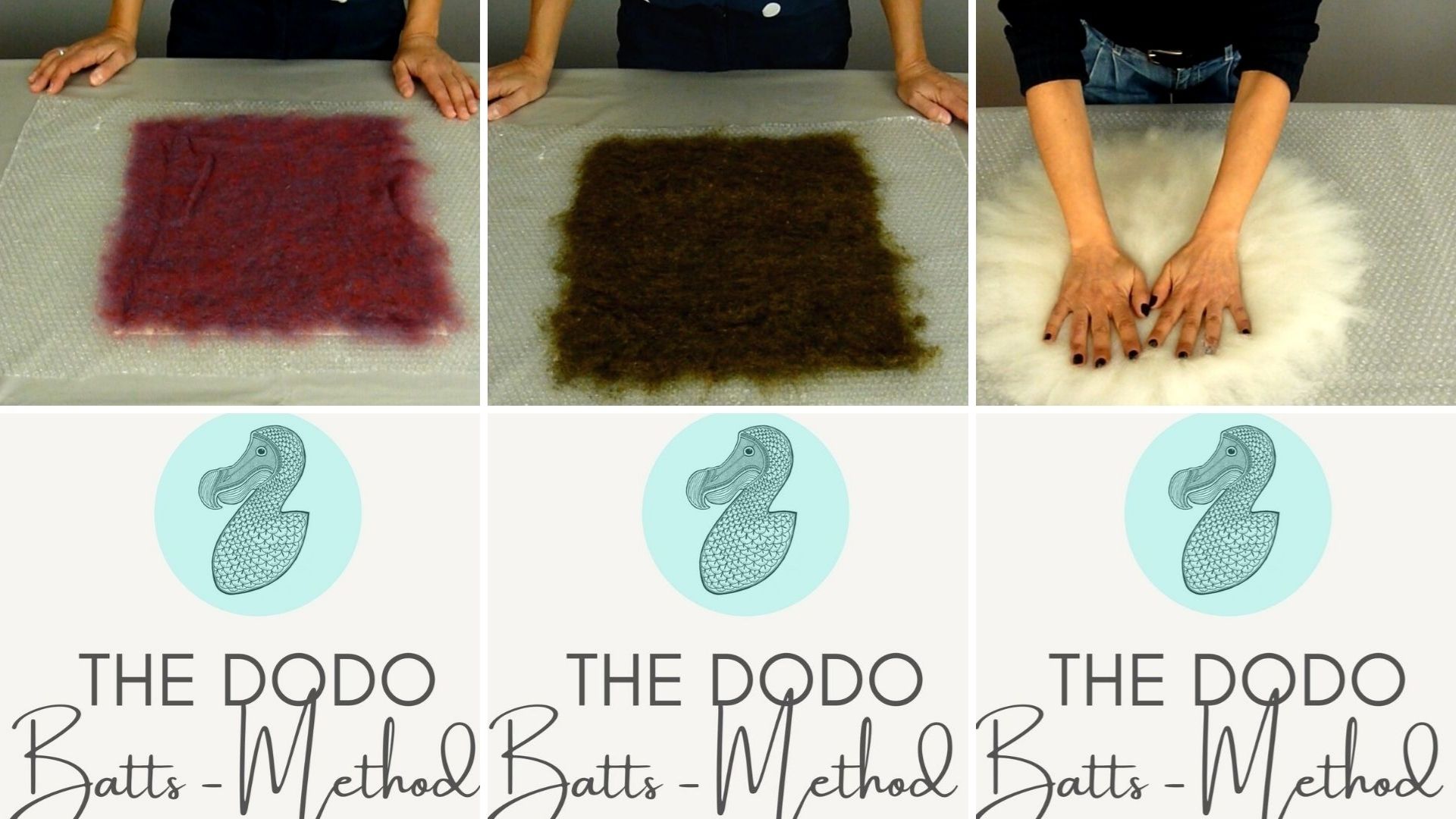The Dodo Blog
How to make fiber paper for beautiful wet felted projects
Fiber paper is a material that you can create with either viscose or silk fiber (viscose paper or silk paper).
You can use it to cut out all sorts of shapes and apply them on wool to make felted pieces with a crisp design, much like what felt makers do with pre-felts.
It looks like actual paper, and because it has a nice sheen, it gives your projects a more luxurious look than wool pre-felts.
It’s pretty easy to make and you just need the fiber plus a liquid that serves as a glue to create the paper sheets.
Some felt makers use sugar or powder gelatine (3 teaspoons dissolved in 100 ml of warm water). Others use starch, and I’ve even seen people apply watered down PVA glue to their fiber.
I’ve tried both sugar water and starch. My favorite is actually sugar water. It’s also the cheapest version. But the one time I tried it, I suddenly had ants in my apartment. So, I’m back to starch now 😊 If you don't have that sort of problem where you live, that might be the best solution for you...
How much bigger should you make a resist to account for shrinkage?
We know that the amount of shrinkage in wet felting depends on many variables. Among the most important are:
- The wool type: breed, microns, fiber length. Fine wool shrinks more than coarser wool.
- The number of wool layers: if they’re odd or even, how many you lay. Also, thin layers shrink more than thick ones.
- The layout method: chevron will shrink more than the traditional layout, for example.
- Decoration: if you add silk, viscose, fabric, or pre-felts.
- Fulling methods: which ones you use, how many times, in which direction, was it evenly fulled, was it fully fulled. Aggressive fulling methods cause more shrinkage than less aggressive ones, as well as more fiber migration.
- Even the water temperature and the way the wool is dyed can influence the way it shrinks.
So, the only way to know what your results will be is to make samples before beginning a project, unless you always work with the same wool type, so you get to know very well how it behaves.
After you’ve made your...
7 tips to create straight and neat edges without cutting or folding the felt
Are you having issues making the edges of your felted projects straight and neat? I know, that’s one of the challenges for us felt makers.
Of course, it’s always possible to cut the felt and heal the edges. But it doesn’t look as nice.
Besides, sometimes, the reason why our felt doesn’t have neat edges is because we made them too thin. In those cases, cutting them doesn’t solve the problem.
So, the only way to really be happy with the edges of our felt is to make them perfect from the start.
If that’s something that has been giving you some headaches, you’ll enjoy this video.
Here are 7 easy-to-follow tips that you can apply in your next felting project to make the edges straight and neat:
Tip 1 – Lay the wool out with the thicker ends on the template edge to have a straight line from the beginning.
Tip 2 – Lay the wool out evenly. This way the wool will also felt evenly.
Tip 3 – Rub the edges from the beginning. We tend to felt more in the center, and that ends up giving us wa...
Wet Felting Demonstration: 3 Layouts For Batts
I’m really excited about this week’s topic because I find there aren’t many wet felters exploring it. And that’s the usage of batts for wet felting.
Batts are more commonly used in needle felting, but they’re definetely worth exploring in wet felting too.
When applied right, batts can:
- save you so much time and effort, since the layout is a lot less laborious than it is for tops
- help you achieve a more even layout
Also, if you're open to wet felting with batts as well as tops, you'll have a wider choice in colors, since often suppliers have a different color palett for batts and tops. And, in my experience, they produce a felt that is a bit different from the one made with tops: less shiny but smoother.
These are 3 new lessons about 3 different ways to lay wool batts, when to use them, as well as the advantages of working with them.
So, if this is something that sparks interest for you, you can access this week’s lessons by signing up for the Free Felting Membership, The D...
New Free Felting Membership
Yes! That's right. I've been working on a free felting membership and it's now available for you to enjoy :)
You see, I’ve been blogging and vlogging about wet felting for over a decade. And what I’ve noticed is that in those formats, it’s easy to lose track of what I’ve already covered since the information is scattered everywhere.
I also wanted a place where you could ask me questions in a way that other felters could also benefit from the answers. So, after considering the pros and cons of the different platforms, I decided this would be the best way to have everything under the same roof.
It's called The Dodo Sandbox because it's a place for you to play, experiment and grow your felting skills :)
The membership area is divided into the “core training” and different chapters or modules, each dedicated to a different topic. When you enter the members’ area, that’s exactly what you see.
Of course, I’ll be creating new modules about other topics as I see what your needs are. And...
Soap In Wet Felting - How To Know If It's Enough
One of the questions I'm asked most often in my live classes is "is this enough soap?"
Felters who aren't very experienced are often unsure about how much soap to apply to their wool fibers. But there are a couple of clues that can help you avoid drowning your project in foam. And that's what I'll go into today.
Before I get into that, I'd like to say that the best way to avoid getting your project too soapy is to add soap slowly and only add more when you notice it’s not enough.
This is why using soapy water is not my preferred method of adding soap to the wool. I like adding water, getting my hands soapy first and only then applying it to the fibers. This way I have more control over how much soap is going into the wool. If you use this method, the tips I have for you today make much more sense.
You’ll know you have the right amount of soap when:
1. The wool doesn't stick to your hands.
When you’re applying soap with the method I mentioned above, you’ll notice the fibers sti...
Creating Your Own Designs
If you’ve followed my work for some time, you’ll know that something I constantly mention is how I like to teach in a way that empowers you to develop your style and explore your creativity.
I see no point in just showing you how to felt an object. When I’m developing my courses, my goal is always to go into the details and the reasons why I’m using a particular technique. That way, you can apply what you’ve learnt in a different project, so you’re free to develop your own designs. That allows you to grow way beyond the methods taught in a tutorial.
That’s one of the reasons I was so happy when I got an email from Audrey Petzold a couple of weeks ago. Audrey bought the tutorial “Felt Food – Fruit” last April and she wanted to know if the basic procedures I used for making the toy fruits could be scaled up to make life size fruits.
I told Audrey it was perfectly possible, and that she just had to make sure that the inner layers were felted enough to apply the next ones. Basically, al...
12 Tips For Nuno Felting – How To Hold Synthetic Decor With Nuno Felt
There are thousands of ways you can decorate a wet felted project. Some just involve wool, others can include silk or other fabrics, as you know. This is then called Nuno felting. But today I bring you a sample that contains wool, silk and something else.
I wanted to show you an example of how you can use a transparent piece of silk to hold any type of synthetic material, that wouldn’t otherwise attach to wool. In this case, I’ll be using a pre-felt and a piece of white silk chiffon with the same size as the pre-felt. Alternatively, you can lay merino wool tops or batts, and use light gauze instead of silk.
TIP # 1 – USE LIGHT GAUZE INSTEAD OF SILK TO MAKE YOUR EXPERIMENTS CHEAPER
I’m also using circles of a synthetic golden fabric (that doesn’t attach to wool), but you can choose countless other materials like small beads or sequins, for example.


If you’re making a sample, please remember to measure the size of the wool now and after shrinkage.
TIP # 2 – ALWAYS MEASURE YOUR SAM...
What To Do When Your Felt Is Stuck?
You plan the piece you want to make.
You draw and cut the resist.
You lay your wool.
Everything is going great, but when you start fulling, your felt just seems to be stuck. Somehow the wool just doesn’t seem to become compact. In fact, nothing seems to happen.
You’ve been felting for hours and you feel tired. What started out as fun is now getting on your nerves. So, you decide to stop.
But then you ask yourself:
WHAT HAPPENS TO MY PROJECT IF I STOP NOW?
IS MY PIECE RUINED?
SHOULD I JUST LEAVE IT ON THE TABLE LIKE THIS? (I ACTUALLY NEED THE TABLE!)
I DON’T EVEN KNOW WHAT WENT WRONG!
Do you recognize the scenario? It’s happened to me dozens of times. The difference when it happens now is that I know exactly what to do.
So – because I suspect it’s happened to you too – I wanted to bring you a couple of tips today on what to do.
Let’s start with “what went wrong”
Well, felting is a physical but also a chemical process. That means that sometimes different factors combine in a...
10 Tips On Wet Felting – How To Wet Felt A Ball Necklace
Today I’ve got a fun tutorial that shows you how to wet felt a ball necklace for children. It’s called Kid’s Dots, and it’s a piece I’ve sold for a long time. Now you get to see how it’s done (for FREE) 🙂
I decided to film this project because Stacy Tavassoli from Truly Majestic invited me to create a tutorial for her arm knitting community. Arm knitting is done with big amounts of wool roving, the same we use for wet felting. But it produces lots of scraps that you can’t use for knitting any more.
So here it is for you. It’s an easy tutorial, which is great for beginners. You won’t need much equipment. Actually, you probably have everything you need at home already. And it shows you 10 tips that are useful for other felting projects.
I’d love to see how your necklaces turned out, so click here to send me your photos 🙂
Have fun!
P.S.: The special Mother’s Day Pack is a 2 for 1 pack for crafty moms, that is only available until May 10. Check out this exclusive offer!




